Microbial Fuel Cell for Electricity Generation and Leachate Treatment
VerifiedAdded on 2022/09/12
|34
|6577
|10
Report
AI Summary
This report delves into the application of Microbial Fuel Cells (MFCs) for electricity generation and leachate treatment, specifically focusing on landfill leachate. The project introduces the concept of MFCs and their potential in treating wastewater while simultaneously producing energy. The report comprises an introduction outlining the aim, objectives, problem statement, scope, and justification of the project. A comprehensive literature survey of five journal articles provides background information on MFC technology, leachate characteristics, and various treatment methods. The methodology section discusses different MFC operational principles, wastewater analysis, and cell voltage determination. The report analyzes the significance of the research and provides an outlook for future developments. The report also includes figures, tables, and abbreviations for clarity, and concludes by summarizing the findings and emphasizing the potential of MFCs as a sustainable solution for wastewater treatment and renewable energy generation. The project is focused on a modern approach to treating leachate using MFCs and highlights the energy-intensive nature of traditional wastewater treatment and the need for more efficient and sustainable technologies.
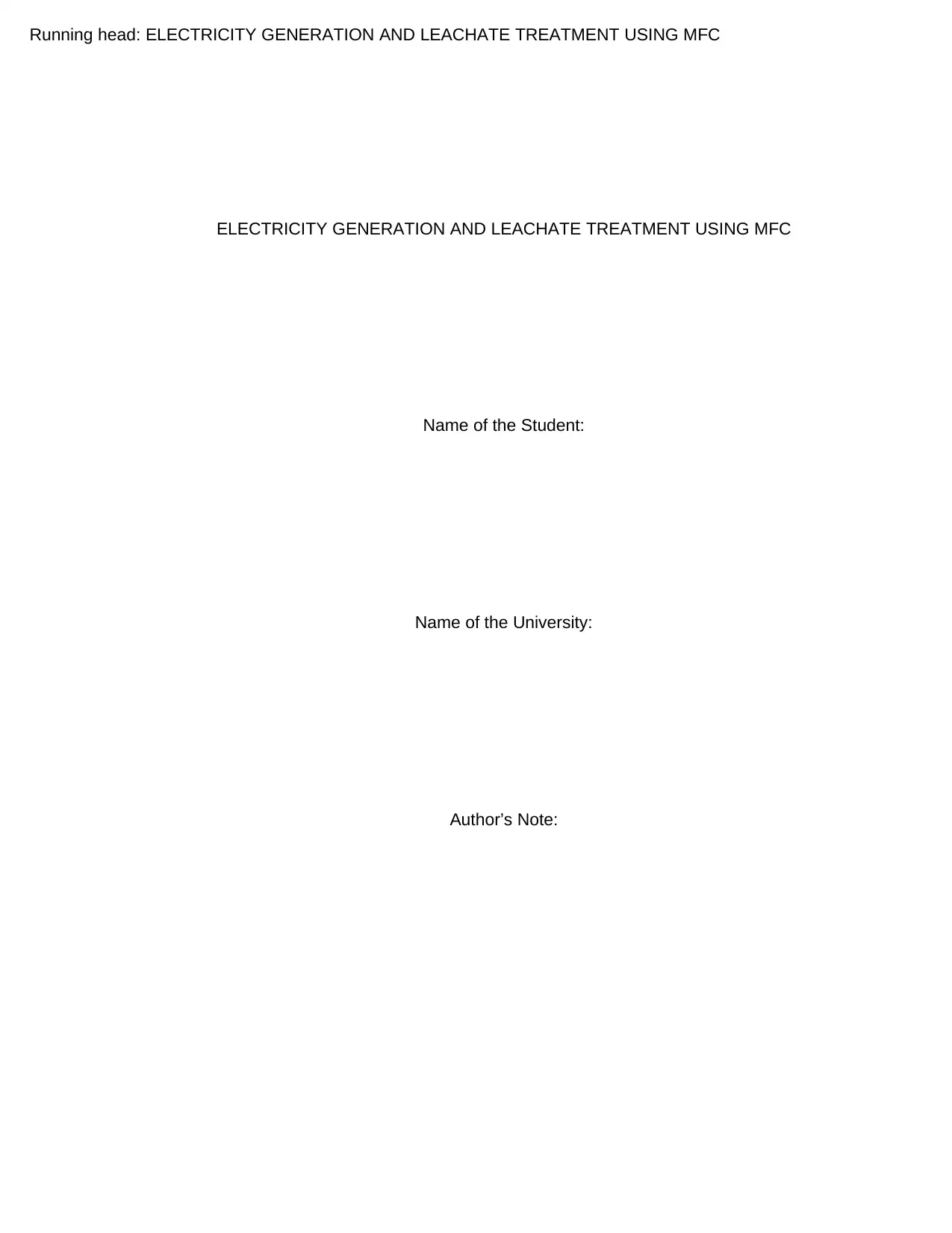
Running head: ELECTRICITY GENERATION AND LEACHATE TREATMENT USING MFC
ELECTRICITY GENERATION AND LEACHATE TREATMENT USING MFC
Name of the Student:
Name of the University:
Author’s Note:
ELECTRICITY GENERATION AND LEACHATE TREATMENT USING MFC
Name of the Student:
Name of the University:
Author’s Note:
Paraphrase This Document
Need a fresh take? Get an instant paraphrase of this document with our AI Paraphraser
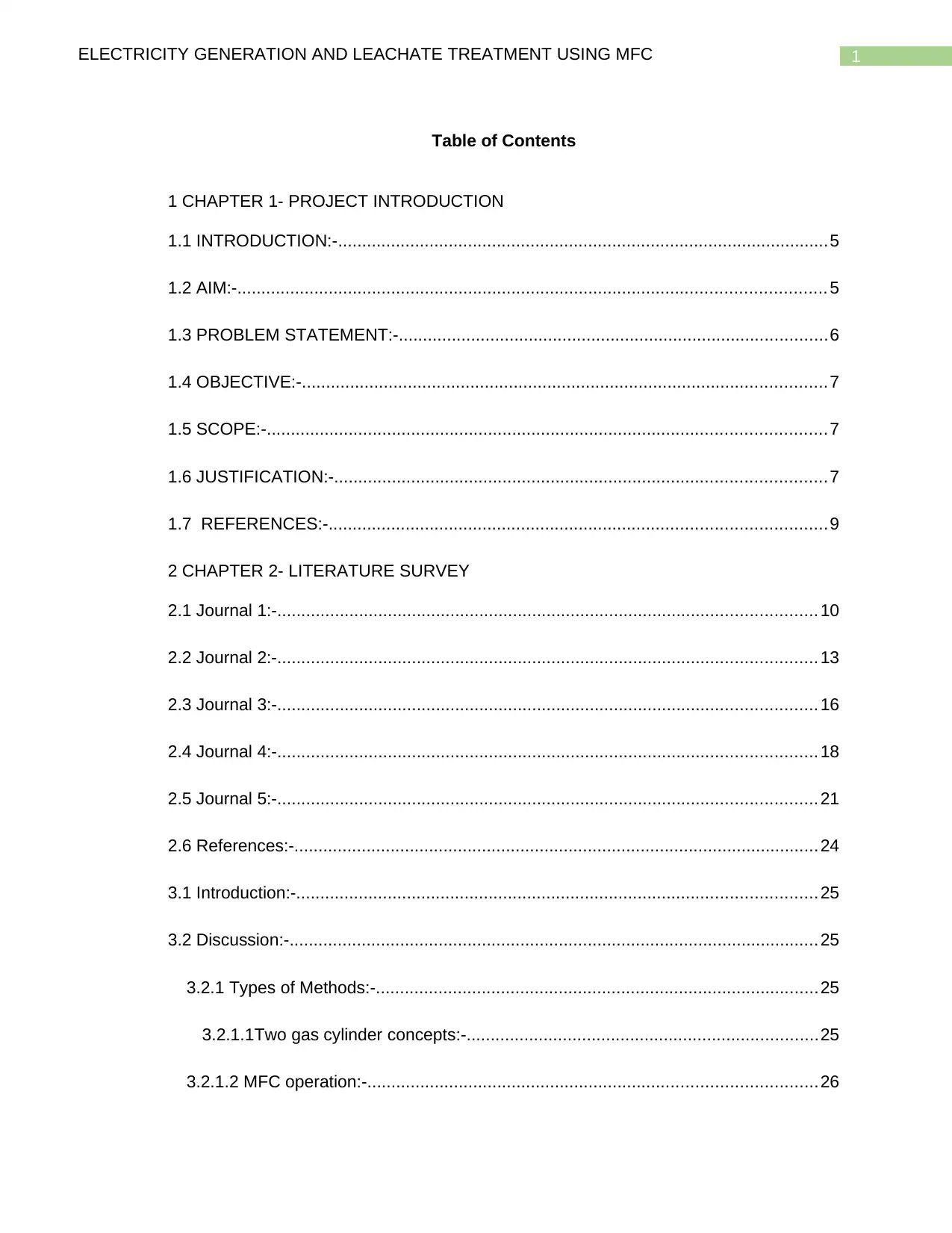
1ELECTRICITY GENERATION AND LEACHATE TREATMENT USING MFC
Table of Contents
1 CHAPTER 1- PROJECT INTRODUCTION
1.1 INTRODUCTION:-......................................................................................................5
1.2 AIM:-.......................................................................................................................... 5
1.3 PROBLEM STATEMENT:-.........................................................................................6
1.4 OBJECTIVE:-.............................................................................................................7
1.5 SCOPE:-....................................................................................................................7
1.6 JUSTIFICATION:-......................................................................................................7
1.7 REFERENCES:-.......................................................................................................9
2 CHAPTER 2- LITERATURE SURVEY
2.1 Journal 1:-................................................................................................................ 10
2.2 Journal 2:-................................................................................................................ 13
2.3 Journal 3:-................................................................................................................ 16
2.4 Journal 4:-................................................................................................................ 18
2.5 Journal 5:-................................................................................................................ 21
2.6 References:-............................................................................................................. 24
3.1 Introduction:-............................................................................................................ 25
3.2 Discussion:-.............................................................................................................. 25
3.2.1 Types of Methods:-............................................................................................25
3.2.1.1Two gas cylinder concepts:-.........................................................................25
3.2.1.2 MFC operation:-.............................................................................................26
Table of Contents
1 CHAPTER 1- PROJECT INTRODUCTION
1.1 INTRODUCTION:-......................................................................................................5
1.2 AIM:-.......................................................................................................................... 5
1.3 PROBLEM STATEMENT:-.........................................................................................6
1.4 OBJECTIVE:-.............................................................................................................7
1.5 SCOPE:-....................................................................................................................7
1.6 JUSTIFICATION:-......................................................................................................7
1.7 REFERENCES:-.......................................................................................................9
2 CHAPTER 2- LITERATURE SURVEY
2.1 Journal 1:-................................................................................................................ 10
2.2 Journal 2:-................................................................................................................ 13
2.3 Journal 3:-................................................................................................................ 16
2.4 Journal 4:-................................................................................................................ 18
2.5 Journal 5:-................................................................................................................ 21
2.6 References:-............................................................................................................. 24
3.1 Introduction:-............................................................................................................ 25
3.2 Discussion:-.............................................................................................................. 25
3.2.1 Types of Methods:-............................................................................................25
3.2.1.1Two gas cylinder concepts:-.........................................................................25
3.2.1.2 MFC operation:-.............................................................................................26

2ELECTRICITY GENERATION AND LEACHATE TREATMENT USING MFC
3.2.1.3Wastewater Leachate:-....................................................................................26
3.2.1.4 MFC calculation in digital Multimeter:-............................................................27
3.2.1.5 Waste Water Analysis:-..................................................................................27
3.2.1.6 Cell voltage Determination:-...........................................................................29
3.2.2Ohmic losses:-....................................................................................................30
3.2.3 Significance of these Research:-...........................................................................31
3.2.4 Outlook:-................................................................................................................ 31
3.3 Conclusion:-............................................................................................................. 32
3.4 References:-............................................................................................................. 33
3.2.1.3Wastewater Leachate:-....................................................................................26
3.2.1.4 MFC calculation in digital Multimeter:-............................................................27
3.2.1.5 Waste Water Analysis:-..................................................................................27
3.2.1.6 Cell voltage Determination:-...........................................................................29
3.2.2Ohmic losses:-....................................................................................................30
3.2.3 Significance of these Research:-...........................................................................31
3.2.4 Outlook:-................................................................................................................ 31
3.3 Conclusion:-............................................................................................................. 32
3.4 References:-............................................................................................................. 33
⊘ This is a preview!⊘
Do you want full access?
Subscribe today to unlock all pages.

Trusted by 1+ million students worldwide

3ELECTRICITY GENERATION AND LEACHATE TREATMENT USING MFC
LIST OF FIGURES
Figure 2.1 Current Generation
Figure 2.2 COD power and current densities
Figure 2.3 Organic Loading rate of Coulombic efficiency
Figure 2.4 Voltage and Power output of Dual Chamber MFC
Figure 2.5 Stability and voltage generation of COD
Figure 2.6 Mean power Density Flow rate
Figure 2.7 BOD5 removal efficiency
Figure 2.8 BOD loading rate
Figure 2.9 Two Chamber MFC
Figure 2.10 Single Chamber MFC
Figure 2.11 COD and BOD removal surface area
Figure 2.12 Density vs. Current Graph
Figure 3.1 MFC in digital Multimeter
Figure 3.2 Cell Voltage Determination
LIST OF TABLES
Table 2.1 Description of Landfill Leachate
Table 2.2 Mean Value of leachate
Table 1.3 MFC Substrates
LIST OF FIGURES
Figure 2.1 Current Generation
Figure 2.2 COD power and current densities
Figure 2.3 Organic Loading rate of Coulombic efficiency
Figure 2.4 Voltage and Power output of Dual Chamber MFC
Figure 2.5 Stability and voltage generation of COD
Figure 2.6 Mean power Density Flow rate
Figure 2.7 BOD5 removal efficiency
Figure 2.8 BOD loading rate
Figure 2.9 Two Chamber MFC
Figure 2.10 Single Chamber MFC
Figure 2.11 COD and BOD removal surface area
Figure 2.12 Density vs. Current Graph
Figure 3.1 MFC in digital Multimeter
Figure 3.2 Cell Voltage Determination
LIST OF TABLES
Table 2.1 Description of Landfill Leachate
Table 2.2 Mean Value of leachate
Table 1.3 MFC Substrates
Paraphrase This Document
Need a fresh take? Get an instant paraphrase of this document with our AI Paraphraser
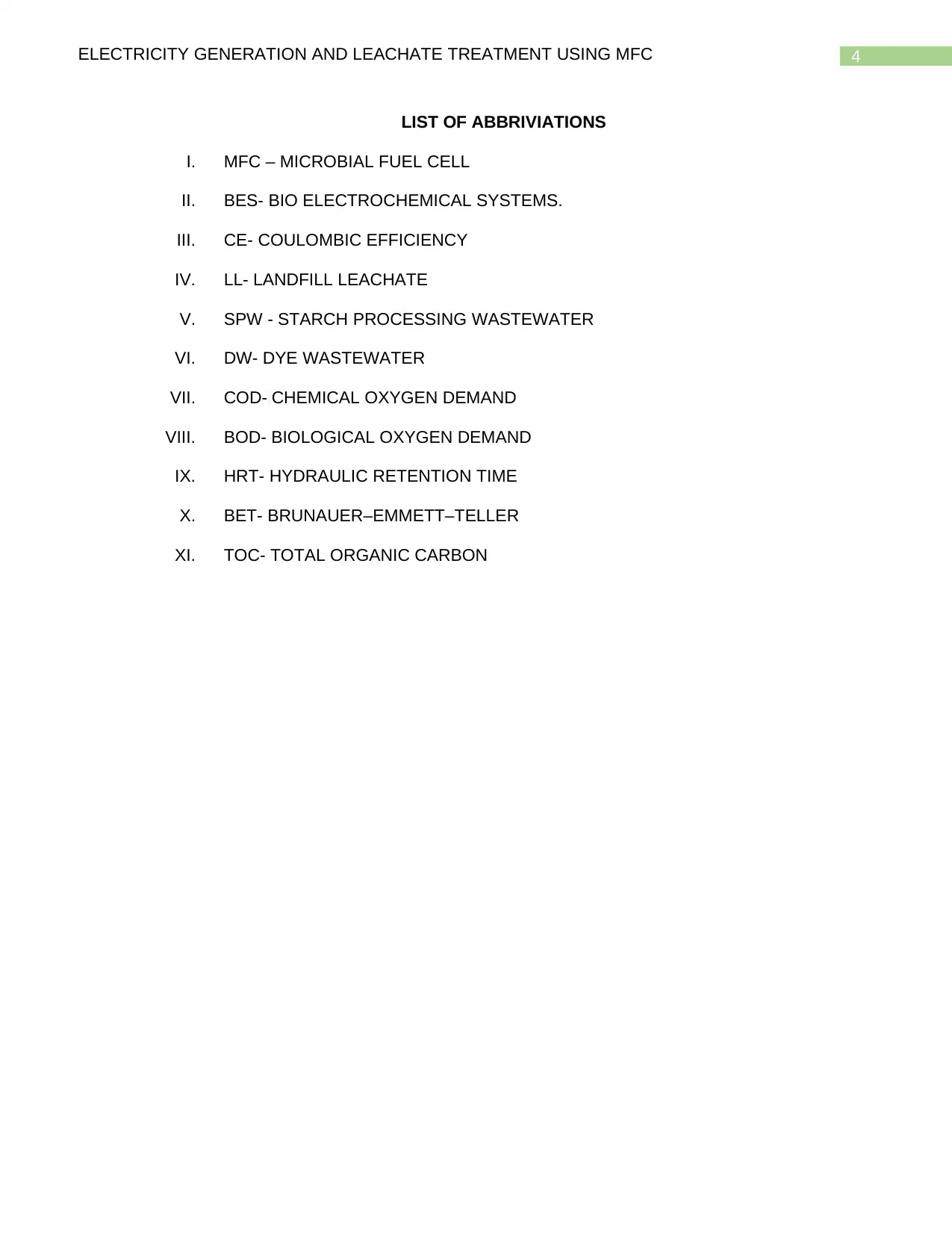
4ELECTRICITY GENERATION AND LEACHATE TREATMENT USING MFC
LIST OF ABBRIVIATIONS
I. MFC – MICROBIAL FUEL CELL
II. BES- BIO ELECTROCHEMICAL SYSTEMS.
III. CE- COULOMBIC EFFICIENCY
IV. LL- LANDFILL LEACHATE
V. SPW - STARCH PROCESSING WASTEWATER
VI. DW- DYE WASTEWATER
VII. COD- CHEMICAL OXYGEN DEMAND
VIII. BOD- BIOLOGICAL OXYGEN DEMAND
IX. HRT- HYDRAULIC RETENTION TIME
X. BET- BRUNAUER–EMMETT–TELLER
XI. TOC- TOTAL ORGANIC CARBON
LIST OF ABBRIVIATIONS
I. MFC – MICROBIAL FUEL CELL
II. BES- BIO ELECTROCHEMICAL SYSTEMS.
III. CE- COULOMBIC EFFICIENCY
IV. LL- LANDFILL LEACHATE
V. SPW - STARCH PROCESSING WASTEWATER
VI. DW- DYE WASTEWATER
VII. COD- CHEMICAL OXYGEN DEMAND
VIII. BOD- BIOLOGICAL OXYGEN DEMAND
IX. HRT- HYDRAULIC RETENTION TIME
X. BET- BRUNAUER–EMMETT–TELLER
XI. TOC- TOTAL ORGANIC CARBON
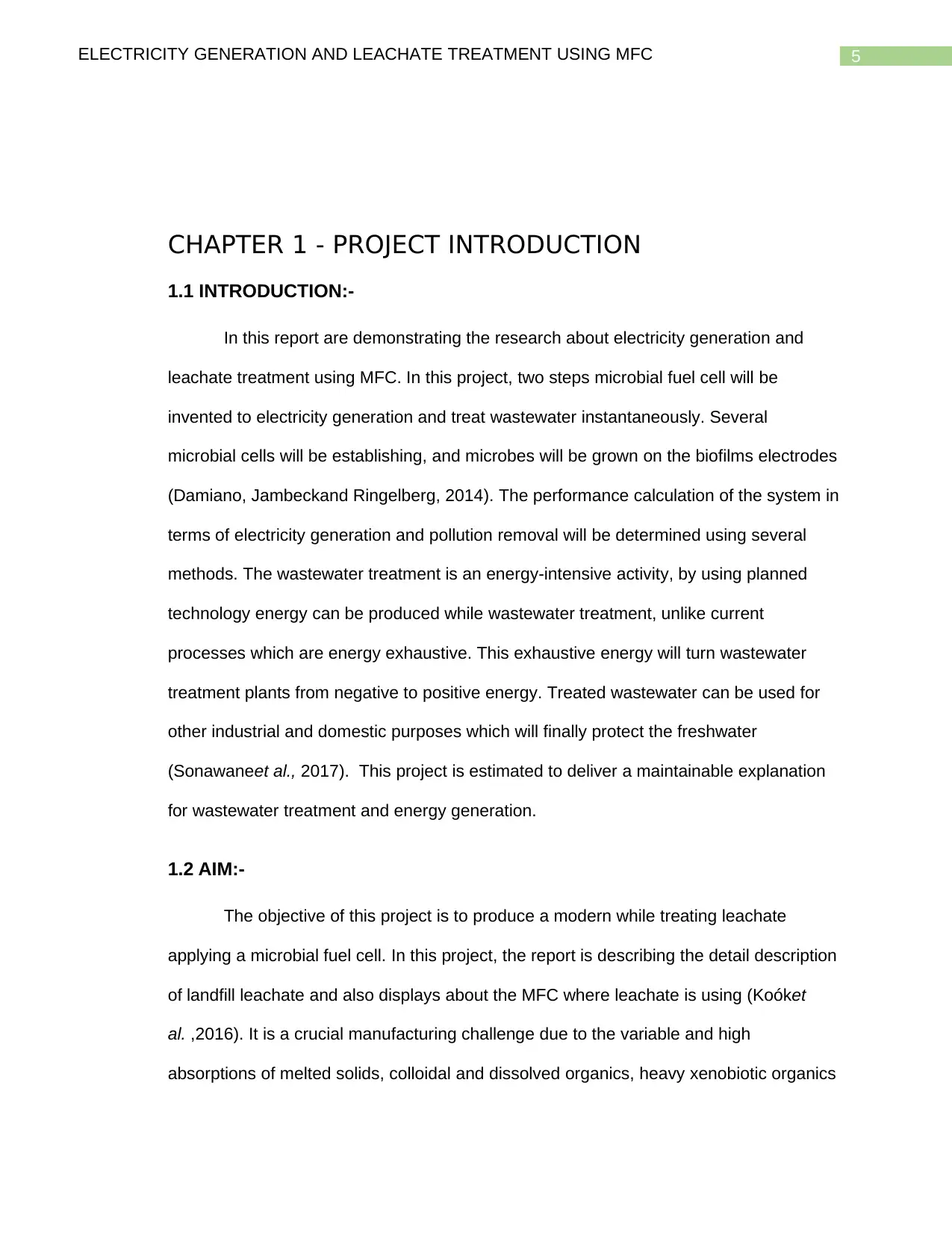
5ELECTRICITY GENERATION AND LEACHATE TREATMENT USING MFC
CHAPTER 1 - PROJECT INTRODUCTION
1.1 INTRODUCTION:-
In this report are demonstrating the research about electricity generation and
leachate treatment using MFC. In this project, two steps microbial fuel cell will be
invented to electricity generation and treat wastewater instantaneously. Several
microbial cells will be establishing, and microbes will be grown on the biofilms electrodes
(Damiano, Jambeckand Ringelberg, 2014). The performance calculation of the system in
terms of electricity generation and pollution removal will be determined using several
methods. The wastewater treatment is an energy-intensive activity, by using planned
technology energy can be produced while wastewater treatment, unlike current
processes which are energy exhaustive. This exhaustive energy will turn wastewater
treatment plants from negative to positive energy. Treated wastewater can be used for
other industrial and domestic purposes which will finally protect the freshwater
(Sonawaneet al., 2017). This project is estimated to deliver a maintainable explanation
for wastewater treatment and energy generation.
1.2 AIM:-
The objective of this project is to produce a modern while treating leachate
applying a microbial fuel cell. In this project, the report is describing the detail description
of landfill leachate and also displays about the MFC where leachate is using (Koóket
al. ,2016). It is a crucial manufacturing challenge due to the variable and high
absorptions of melted solids, colloidal and dissolved organics, heavy xenobiotic organics
CHAPTER 1 - PROJECT INTRODUCTION
1.1 INTRODUCTION:-
In this report are demonstrating the research about electricity generation and
leachate treatment using MFC. In this project, two steps microbial fuel cell will be
invented to electricity generation and treat wastewater instantaneously. Several
microbial cells will be establishing, and microbes will be grown on the biofilms electrodes
(Damiano, Jambeckand Ringelberg, 2014). The performance calculation of the system in
terms of electricity generation and pollution removal will be determined using several
methods. The wastewater treatment is an energy-intensive activity, by using planned
technology energy can be produced while wastewater treatment, unlike current
processes which are energy exhaustive. This exhaustive energy will turn wastewater
treatment plants from negative to positive energy. Treated wastewater can be used for
other industrial and domestic purposes which will finally protect the freshwater
(Sonawaneet al., 2017). This project is estimated to deliver a maintainable explanation
for wastewater treatment and energy generation.
1.2 AIM:-
The objective of this project is to produce a modern while treating leachate
applying a microbial fuel cell. In this project, the report is describing the detail description
of landfill leachate and also displays about the MFC where leachate is using (Koóket
al. ,2016). It is a crucial manufacturing challenge due to the variable and high
absorptions of melted solids, colloidal and dissolved organics, heavy xenobiotic organics
⊘ This is a preview!⊘
Do you want full access?
Subscribe today to unlock all pages.

Trusted by 1+ million students worldwide
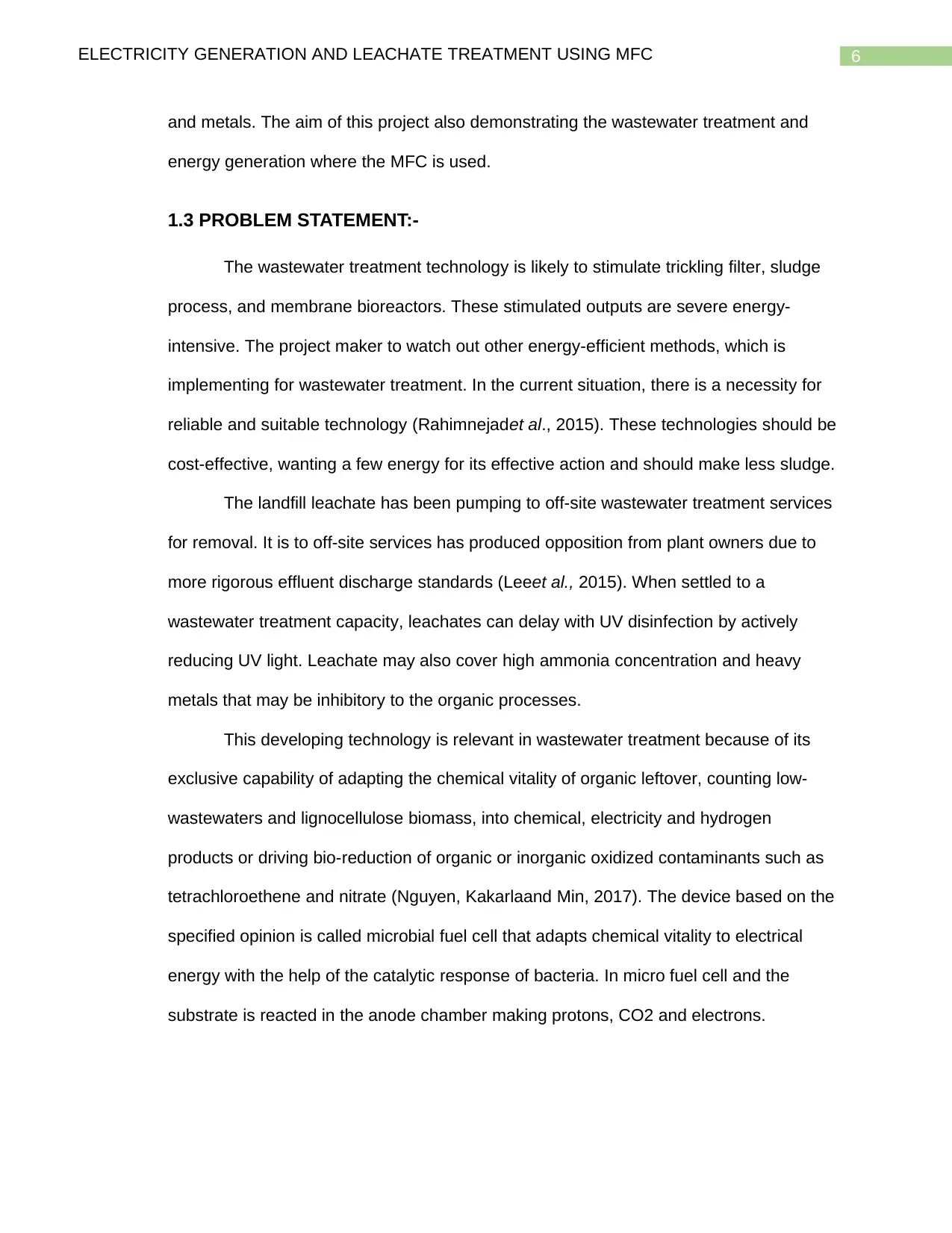
6ELECTRICITY GENERATION AND LEACHATE TREATMENT USING MFC
and metals. The aim of this project also demonstrating the wastewater treatment and
energy generation where the MFC is used.
1.3 PROBLEM STATEMENT:-
The wastewater treatment technology is likely to stimulate trickling filter, sludge
process, and membrane bioreactors. These stimulated outputs are severe energy-
intensive. The project maker to watch out other energy-efficient methods, which is
implementing for wastewater treatment. In the current situation, there is a necessity for
reliable and suitable technology (Rahimnejadet al., 2015). These technologies should be
cost-effective, wanting a few energy for its effective action and should make less sludge.
The landfill leachate has been pumping to off-site wastewater treatment services
for removal. It is to off-site services has produced opposition from plant owners due to
more rigorous effluent discharge standards (Leeet al., 2015). When settled to a
wastewater treatment capacity, leachates can delay with UV disinfection by actively
reducing UV light. Leachate may also cover high ammonia concentration and heavy
metals that may be inhibitory to the organic processes.
This developing technology is relevant in wastewater treatment because of its
exclusive capability of adapting the chemical vitality of organic leftover, counting low-
wastewaters and lignocellulose biomass, into chemical, electricity and hydrogen
products or driving bio-reduction of organic or inorganic oxidized contaminants such as
tetrachloroethene and nitrate (Nguyen, Kakarlaand Min, 2017). The device based on the
specified opinion is called microbial fuel cell that adapts chemical vitality to electrical
energy with the help of the catalytic response of bacteria. In micro fuel cell and the
substrate is reacted in the anode chamber making protons, CO2 and electrons.
and metals. The aim of this project also demonstrating the wastewater treatment and
energy generation where the MFC is used.
1.3 PROBLEM STATEMENT:-
The wastewater treatment technology is likely to stimulate trickling filter, sludge
process, and membrane bioreactors. These stimulated outputs are severe energy-
intensive. The project maker to watch out other energy-efficient methods, which is
implementing for wastewater treatment. In the current situation, there is a necessity for
reliable and suitable technology (Rahimnejadet al., 2015). These technologies should be
cost-effective, wanting a few energy for its effective action and should make less sludge.
The landfill leachate has been pumping to off-site wastewater treatment services
for removal. It is to off-site services has produced opposition from plant owners due to
more rigorous effluent discharge standards (Leeet al., 2015). When settled to a
wastewater treatment capacity, leachates can delay with UV disinfection by actively
reducing UV light. Leachate may also cover high ammonia concentration and heavy
metals that may be inhibitory to the organic processes.
This developing technology is relevant in wastewater treatment because of its
exclusive capability of adapting the chemical vitality of organic leftover, counting low-
wastewaters and lignocellulose biomass, into chemical, electricity and hydrogen
products or driving bio-reduction of organic or inorganic oxidized contaminants such as
tetrachloroethene and nitrate (Nguyen, Kakarlaand Min, 2017). The device based on the
specified opinion is called microbial fuel cell that adapts chemical vitality to electrical
energy with the help of the catalytic response of bacteria. In micro fuel cell and the
substrate is reacted in the anode chamber making protons, CO2 and electrons.
Paraphrase This Document
Need a fresh take? Get an instant paraphrase of this document with our AI Paraphraser
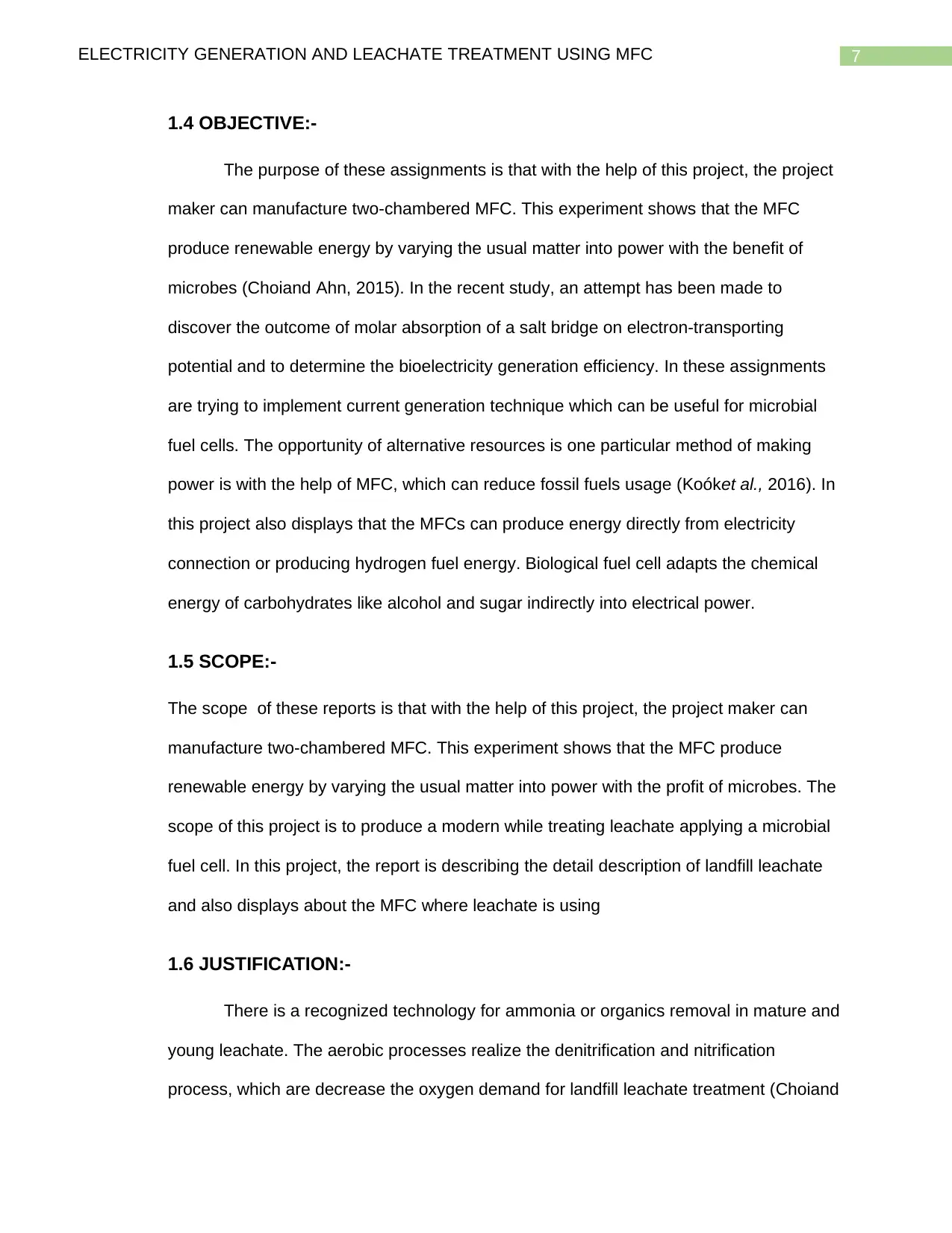
7ELECTRICITY GENERATION AND LEACHATE TREATMENT USING MFC
1.4 OBJECTIVE:-
The purpose of these assignments is that with the help of this project, the project
maker can manufacture two-chambered MFC. This experiment shows that the MFC
produce renewable energy by varying the usual matter into power with the benefit of
microbes (Choiand Ahn, 2015). In the recent study, an attempt has been made to
discover the outcome of molar absorption of a salt bridge on electron-transporting
potential and to determine the bioelectricity generation efficiency. In these assignments
are trying to implement current generation technique which can be useful for microbial
fuel cells. The opportunity of alternative resources is one particular method of making
power is with the help of MFC, which can reduce fossil fuels usage (Koóket al., 2016). In
this project also displays that the MFCs can produce energy directly from electricity
connection or producing hydrogen fuel energy. Biological fuel cell adapts the chemical
energy of carbohydrates like alcohol and sugar indirectly into electrical power.
1.5 SCOPE:-
The scope of these reports is that with the help of this project, the project maker can
manufacture two-chambered MFC. This experiment shows that the MFC produce
renewable energy by varying the usual matter into power with the profit of microbes. The
scope of this project is to produce a modern while treating leachate applying a microbial
fuel cell. In this project, the report is describing the detail description of landfill leachate
and also displays about the MFC where leachate is using
1.6 JUSTIFICATION:-
There is a recognized technology for ammonia or organics removal in mature and
young leachate. The aerobic processes realize the denitrification and nitrification
process, which are decrease the oxygen demand for landfill leachate treatment (Choiand
1.4 OBJECTIVE:-
The purpose of these assignments is that with the help of this project, the project
maker can manufacture two-chambered MFC. This experiment shows that the MFC
produce renewable energy by varying the usual matter into power with the benefit of
microbes (Choiand Ahn, 2015). In the recent study, an attempt has been made to
discover the outcome of molar absorption of a salt bridge on electron-transporting
potential and to determine the bioelectricity generation efficiency. In these assignments
are trying to implement current generation technique which can be useful for microbial
fuel cells. The opportunity of alternative resources is one particular method of making
power is with the help of MFC, which can reduce fossil fuels usage (Koóket al., 2016). In
this project also displays that the MFCs can produce energy directly from electricity
connection or producing hydrogen fuel energy. Biological fuel cell adapts the chemical
energy of carbohydrates like alcohol and sugar indirectly into electrical power.
1.5 SCOPE:-
The scope of these reports is that with the help of this project, the project maker can
manufacture two-chambered MFC. This experiment shows that the MFC produce
renewable energy by varying the usual matter into power with the profit of microbes. The
scope of this project is to produce a modern while treating leachate applying a microbial
fuel cell. In this project, the report is describing the detail description of landfill leachate
and also displays about the MFC where leachate is using
1.6 JUSTIFICATION:-
There is a recognized technology for ammonia or organics removal in mature and
young leachate. The aerobic processes realize the denitrification and nitrification
process, which are decrease the oxygen demand for landfill leachate treatment (Choiand
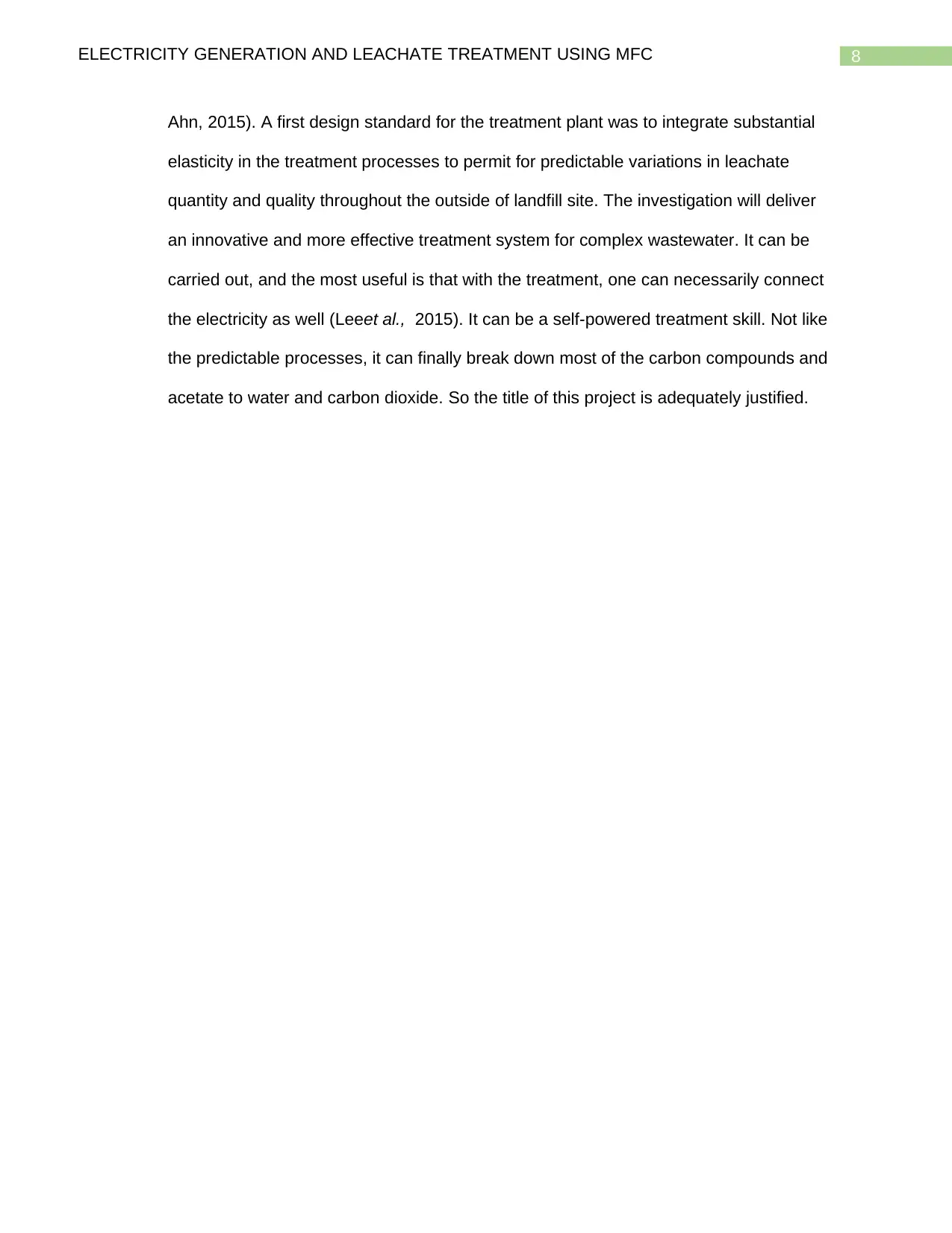
8ELECTRICITY GENERATION AND LEACHATE TREATMENT USING MFC
Ahn, 2015). A first design standard for the treatment plant was to integrate substantial
elasticity in the treatment processes to permit for predictable variations in leachate
quantity and quality throughout the outside of landfill site. The investigation will deliver
an innovative and more effective treatment system for complex wastewater. It can be
carried out, and the most useful is that with the treatment, one can necessarily connect
the electricity as well (Leeet al., 2015). It can be a self-powered treatment skill. Not like
the predictable processes, it can finally break down most of the carbon compounds and
acetate to water and carbon dioxide. So the title of this project is adequately justified.
Ahn, 2015). A first design standard for the treatment plant was to integrate substantial
elasticity in the treatment processes to permit for predictable variations in leachate
quantity and quality throughout the outside of landfill site. The investigation will deliver
an innovative and more effective treatment system for complex wastewater. It can be
carried out, and the most useful is that with the treatment, one can necessarily connect
the electricity as well (Leeet al., 2015). It can be a self-powered treatment skill. Not like
the predictable processes, it can finally break down most of the carbon compounds and
acetate to water and carbon dioxide. So the title of this project is adequately justified.
⊘ This is a preview!⊘
Do you want full access?
Subscribe today to unlock all pages.

Trusted by 1+ million students worldwide

9ELECTRICITY GENERATION AND LEACHATE TREATMENT USING MFC
1.7 REFERENCES:-
Choi, J. and Ahn, Y., 2015. Enhanced bioelectricity harvesting in microbial fuel cells
treating food waste leachate produced from biohydrogen fermentation.
Bioresource technology, 183, pp.53-60.
Damiano, L., Jambeck, J.R. and Ringelberg, D.B., 2014. Municipal solid waste landfill
leachate treatment and electricity production using microbial fuel cells. Applied
biochemistry and biotechnology, 173(2), pp.472-485.
Koók, L., Rózsenberszki, T., Nemestóthy, N., Bélafi-Bakó, K. and Bakonyi, P., 2016.
Bioelectrochemical treatment of municipal waste liquor in microbial fuel cells for
energy valorization. Journal of Cleaner Production, 112, pp.4406-4412.
Lee, D.J., Chang, J.S. and Lai, J.Y., 2015. Microalgae–microbial fuel cell: a mini review.
Bioresource technology, 198, pp.891-895.
Nguyen, H.T., Kakarla, R. and Min, B., 2017. Algae cathode microbial fuel cells for
electricity generation and nutrient removal from landfill leachate wastewater.
International Journal of Hydrogen Energy, 42(49), pp.29433-29442.
Rahimnejad, M., Adhami, A., Darvari, S., Zirepour, A. and Oh, S.E., 2015. Microbial fuel
cell as new technology for bioelectricity generation: a review. Alexandria
Engineering Journal, 54(3), pp.745-756.
Sonawane, J.M., Adeloju, S.B. and Ghosh, P.C., 2017. Landfill leachate: A promising
substrate for microbial fuel cells. International Journal of Hydrogen Energy,
42(37), pp.23794-23798.
1.7 REFERENCES:-
Choi, J. and Ahn, Y., 2015. Enhanced bioelectricity harvesting in microbial fuel cells
treating food waste leachate produced from biohydrogen fermentation.
Bioresource technology, 183, pp.53-60.
Damiano, L., Jambeck, J.R. and Ringelberg, D.B., 2014. Municipal solid waste landfill
leachate treatment and electricity production using microbial fuel cells. Applied
biochemistry and biotechnology, 173(2), pp.472-485.
Koók, L., Rózsenberszki, T., Nemestóthy, N., Bélafi-Bakó, K. and Bakonyi, P., 2016.
Bioelectrochemical treatment of municipal waste liquor in microbial fuel cells for
energy valorization. Journal of Cleaner Production, 112, pp.4406-4412.
Lee, D.J., Chang, J.S. and Lai, J.Y., 2015. Microalgae–microbial fuel cell: a mini review.
Bioresource technology, 198, pp.891-895.
Nguyen, H.T., Kakarla, R. and Min, B., 2017. Algae cathode microbial fuel cells for
electricity generation and nutrient removal from landfill leachate wastewater.
International Journal of Hydrogen Energy, 42(49), pp.29433-29442.
Rahimnejad, M., Adhami, A., Darvari, S., Zirepour, A. and Oh, S.E., 2015. Microbial fuel
cell as new technology for bioelectricity generation: a review. Alexandria
Engineering Journal, 54(3), pp.745-756.
Sonawane, J.M., Adeloju, S.B. and Ghosh, P.C., 2017. Landfill leachate: A promising
substrate for microbial fuel cells. International Journal of Hydrogen Energy,
42(37), pp.23794-23798.
Paraphrase This Document
Need a fresh take? Get an instant paraphrase of this document with our AI Paraphraser
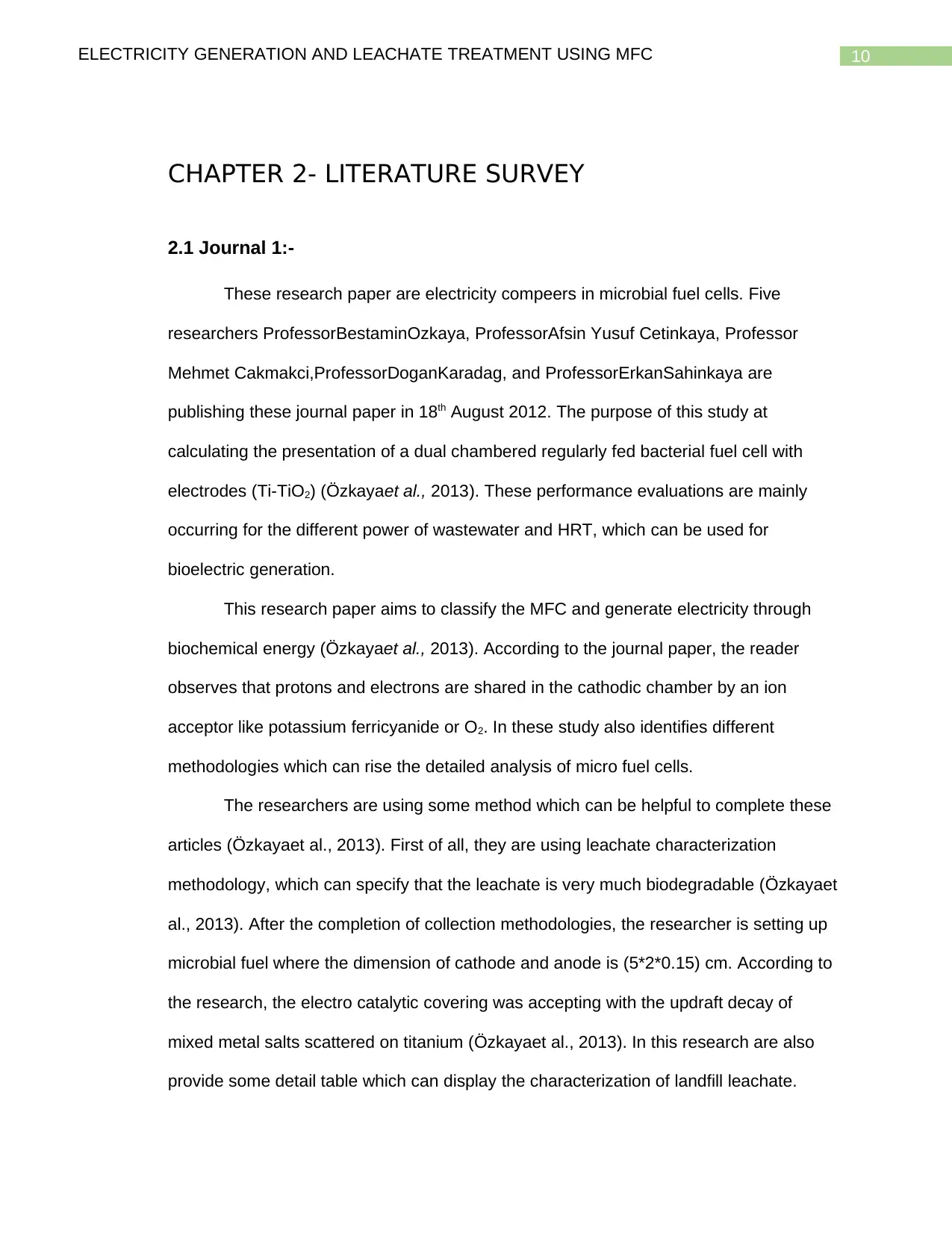
10ELECTRICITY GENERATION AND LEACHATE TREATMENT USING MFC
CHAPTER 2- LITERATURE SURVEY
2.1 Journal 1:-
These research paper are electricity compeers in microbial fuel cells. Five
researchers ProfessorBestaminOzkaya, ProfessorAfsin Yusuf Cetinkaya, Professor
Mehmet Cakmakci,ProfessorDoganKaradag, and ProfessorErkanSahinkaya are
publishing these journal paper in 18th August 2012. The purpose of this study at
calculating the presentation of a dual chambered regularly fed bacterial fuel cell with
electrodes (Ti-TiO2) (Özkayaet al., 2013). These performance evaluations are mainly
occurring for the different power of wastewater and HRT, which can be used for
bioelectric generation.
This research paper aims to classify the MFC and generate electricity through
biochemical energy (Özkayaet al., 2013). According to the journal paper, the reader
observes that protons and electrons are shared in the cathodic chamber by an ion
acceptor like potassium ferricyanide or O2. In these study also identifies different
methodologies which can rise the detailed analysis of micro fuel cells.
The researchers are using some method which can be helpful to complete these
articles (Özkayaet al., 2013). First of all, they are using leachate characterization
methodology, which can specify that the leachate is very much biodegradable (Özkayaet
al., 2013). After the completion of collection methodologies, the researcher is setting up
microbial fuel where the dimension of cathode and anode is (5*2*0.15) cm. According to
the research, the electro catalytic covering was accepting with the updraft decay of
mixed metal salts scattered on titanium (Özkayaet al., 2013). In this research are also
provide some detail table which can display the characterization of landfill leachate.
CHAPTER 2- LITERATURE SURVEY
2.1 Journal 1:-
These research paper are electricity compeers in microbial fuel cells. Five
researchers ProfessorBestaminOzkaya, ProfessorAfsin Yusuf Cetinkaya, Professor
Mehmet Cakmakci,ProfessorDoganKaradag, and ProfessorErkanSahinkaya are
publishing these journal paper in 18th August 2012. The purpose of this study at
calculating the presentation of a dual chambered regularly fed bacterial fuel cell with
electrodes (Ti-TiO2) (Özkayaet al., 2013). These performance evaluations are mainly
occurring for the different power of wastewater and HRT, which can be used for
bioelectric generation.
This research paper aims to classify the MFC and generate electricity through
biochemical energy (Özkayaet al., 2013). According to the journal paper, the reader
observes that protons and electrons are shared in the cathodic chamber by an ion
acceptor like potassium ferricyanide or O2. In these study also identifies different
methodologies which can rise the detailed analysis of micro fuel cells.
The researchers are using some method which can be helpful to complete these
articles (Özkayaet al., 2013). First of all, they are using leachate characterization
methodology, which can specify that the leachate is very much biodegradable (Özkayaet
al., 2013). After the completion of collection methodologies, the researcher is setting up
microbial fuel where the dimension of cathode and anode is (5*2*0.15) cm. According to
the research, the electro catalytic covering was accepting with the updraft decay of
mixed metal salts scattered on titanium (Özkayaet al., 2013). In this research are also
provide some detail table which can display the characterization of landfill leachate.
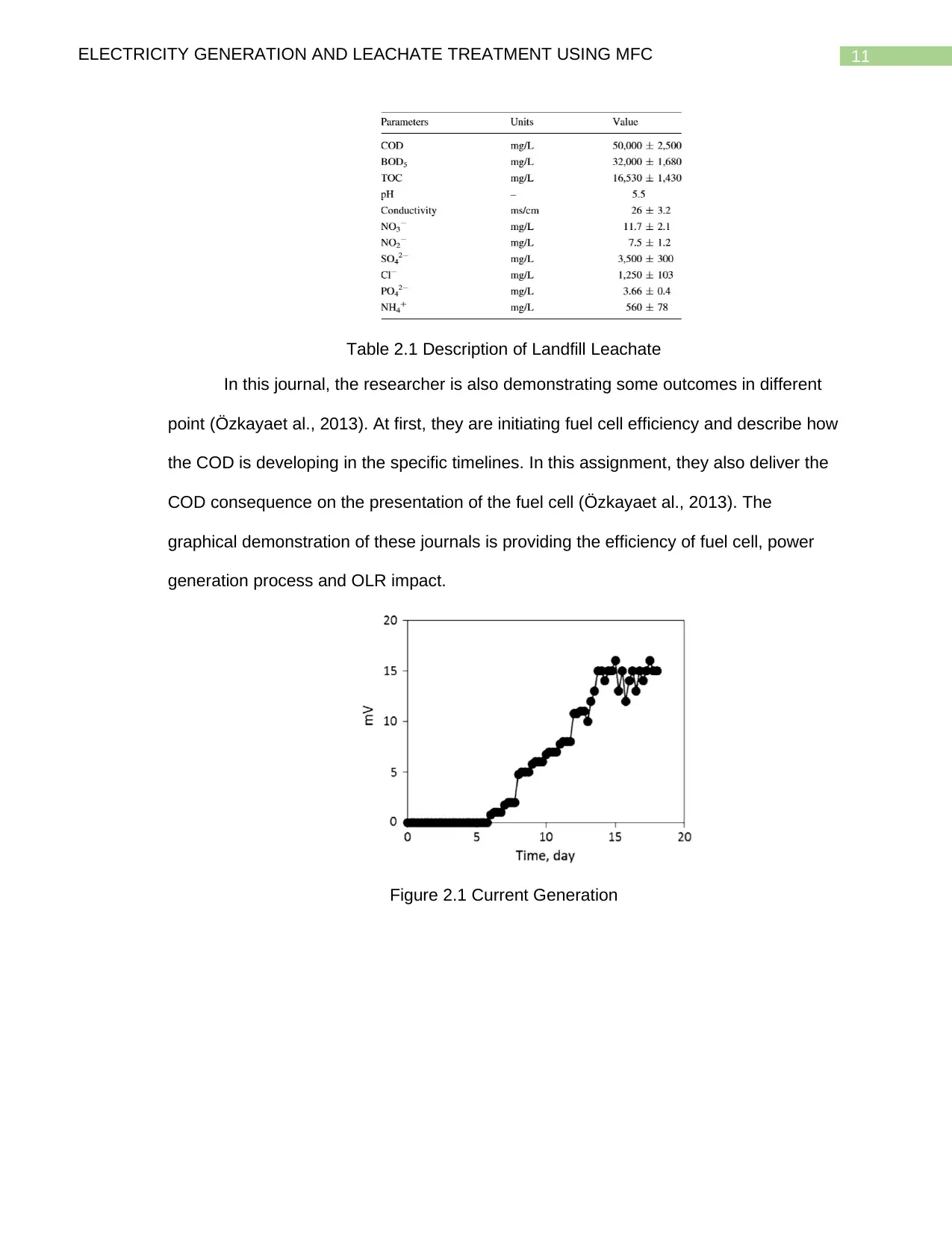
11ELECTRICITY GENERATION AND LEACHATE TREATMENT USING MFC
Table 2.1 Description of Landfill Leachate
In this journal, the researcher is also demonstrating some outcomes in different
point (Özkayaet al., 2013). At first, they are initiating fuel cell efficiency and describe how
the COD is developing in the specific timelines. In this assignment, they also deliver the
COD consequence on the presentation of the fuel cell (Özkayaet al., 2013). The
graphical demonstration of these journals is providing the efficiency of fuel cell, power
generation process and OLR impact.
Figure 2.1 Current Generation
Table 2.1 Description of Landfill Leachate
In this journal, the researcher is also demonstrating some outcomes in different
point (Özkayaet al., 2013). At first, they are initiating fuel cell efficiency and describe how
the COD is developing in the specific timelines. In this assignment, they also deliver the
COD consequence on the presentation of the fuel cell (Özkayaet al., 2013). The
graphical demonstration of these journals is providing the efficiency of fuel cell, power
generation process and OLR impact.
Figure 2.1 Current Generation
⊘ This is a preview!⊘
Do you want full access?
Subscribe today to unlock all pages.

Trusted by 1+ million students worldwide
1 out of 34
Your All-in-One AI-Powered Toolkit for Academic Success.
+13062052269
info@desklib.com
Available 24*7 on WhatsApp / Email
![[object Object]](/_next/static/media/star-bottom.7253800d.svg)
Unlock your academic potential
Copyright © 2020–2025 A2Z Services. All Rights Reserved. Developed and managed by ZUCOL.